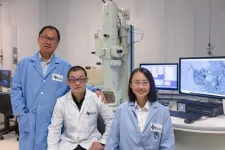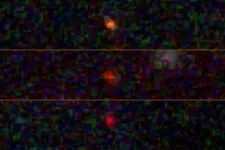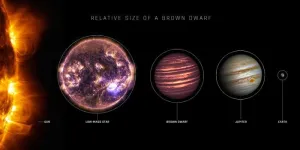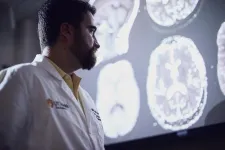(Press-News.org) University of Texas at Dallas scientists have discovered a previously unknown “housekeeping” process in kidney cells that ejects unwanted content, resulting in cells that rejuvenate themselves and remain functioning and healthy.
The self-renewal process, which is fundamentally different from how other bodily tissues are thought to regenerate, helps explain how, barring injury or disease, the kidneys can remain healthy for a lifetime. The researchers described the mechanism in a study published April 17 in Nature Nanotechnology.
Unlike the liver and skin, where cells divide to create new daughter cells and regenerate the organ, cells in the proximal tubules of the kidney are mitotically quiescent — they do not divide to create new cells. In cases of mild injury or disease, kidney cells do have limited repair capabilities, and stem cells in the kidney can form new kidney cells, but only up to a point, said Dr. Jie Zheng, professor of chemistry and biochemistry in the School of Natural Sciences and Mathematics and co-corresponding author of the study.
“In most scenarios, if kidney cells are severely injured, they will die, and they cannot regenerate,” said Zheng, a Distinguished Chair in Natural Sciences and Mathematics. “Your kidney will just fail sooner or later. That’s a big challenge in health management for kidney disease. All we can do currently is slow down the progression to kidney failure. We cannot easily repair the organ if it’s injured severely or by chronic disease.
“That’s why discovering this self-renewal mechanism is probably one of the most significant findings we’ve made so far. With excellent core facilities and dedicated staff, UTD is a great place to do such cutting-edge research.”
Further research may lead to improvements in nanomedicine and early detection of kidney disease, he said.
An Unexpected Finding
The researchers said their discovery took them by surprise.
For 15 years, Zheng has been investigating the biomedical use of gold nanoparticles as imaging agents, for fundamental understanding of glomerular filtration, for early detection of liver disease, and for targeted delivery of cancer drugs. Part of that work has focused on understanding how gold nanoparticles are filtered by the kidneys and cleared from the body through urine.
Research has shown that gold nanoparticles generally pass unscathed through a structure in the kidney called the glomerulus and then travel into proximal tubules, which make up over 50% of the kidney. Proximal tubular epithelial cells have been shown to internalize the nanoparticles, which eventually escape those cells to be excreted in urine. But just how they escape the cells has been unclear.
In December 2021, Zheng and his chemistry team — research scientist and lead study author Yingyu Huang PhD’20 and co-corresponding author Dr. Mengxiao Yu, research associate professor — were examining gold nanoparticles in proximal tubular tissue samples using an optical microscope, but they switched to one of the University’s electron microscopes (EM) for better resolution.
“Using the EM, we saw gold nanoparticles encapsulated in lysosomes inside of large vesicles in the lumen, which is the space outside the epithelial cells,” Yu said.
Vesicles are small fluid-filled sacks found both inside and outside of cells that transport various substances.
“But we also observed the formation of these vesicles containing both nanoparticles and organelles outside of cells, and it was not something we had seen before,” Yu said.
The researchers found proximal tubular cells that had formed outwardly facing bulges in their luminal membranes that contained not only gold nanoparticles but also lysosomes, mitochondria, endoplasmic reticulum and other organelles typically confined to a cell’s interior. The extruded contents were then pinched off into a vesicle that floated off into the extracellular space.
“At that moment, we knew this was an unusual phenomenon,” Yu said. “This is a new method for cells to remove cellular contents.”
A New Renewal Process
The extrusion-mediated self-renewal mechanism is fundamentally different from other known regenerative processes — such as cell division — and housecleaning tasks like exocytosis. In exocytosis, foreign substances such as nanoparticles are encapsulated in a vesicle inside the cell. Then, the vesicle membrane fuses with the inside of the cell’s membrane, which opens to release the contents to the outside.
“What we discovered is totally different from the previous understanding of how cells eliminate particles. There is no membrane fusion in the extrusion process, which eliminates old content from normal cells and allows the cells to update themselves with fresh contents,” Huang said. “It happens whether foreign nanoparticles are present or not. It’s an intrinsic, proactive process these cells use to survive longer and function properly.”
Zheng said their findings open up new areas of study. For example, epithelial cells, like those in the proximal tubules, are found in other tissues, such as the walls of arteries and in the gut and digestive tract.
“In the field of nanomedicine, we want to minimize accumulation of nanoparticles in the body as much as possible. We don’t want them to get stuck in the kidneys, so it’s very important to understand how nanoparticles are eliminated from the proximal tubules,” Zheng said. “Also, if we could learn how to regulate or monitor this self-renewal process, we might find a way to keep kidneys healthy in patients with high blood pressure or diabetes.
“If we could develop ways to detect the signature of this process noninvasively, perhaps it could be an indicator of early kidney disease.”
The research was funded by the National Institute of Diabetes and Digestive and Kidney Diseases (R01DK124881, R01DK115986, R01DK126140 and R01DK103363), the National Science Foundation and the Cancer Prevention and Research Institute of Texas.
END
Researchers’ sweeping discovery shows how kidney cells self-renew
2023-07-13
ELSE PRESS RELEASES FROM THIS DATE:
Rensselaer researcher receives grant to study enzymes in deep sea organisms
2023-07-13
Rensselaer Polytechnic Institute’s Catherine Royer, Constellation Chair Professor of Bioinformatics and Biocomputation at the Shirley Ann Jackson, Ph.D. Center for Biotechnology and Interdisciplinary Studies (CBIS) and professor of biological sciences, has received a grant of over $400,000 from the National Science Foundation to investigate enzymes from organisms living in deep sea environments.
“Ultimately, I hope to better understand how these enzymes function under the high pressure that is present in the deep sea,” said Royer. “They also thrive in high or low temperatures. Biomolecules from the surface do not have the ability to survive these extreme ...
Penn State researchers receive $1M NSF award to develop hemp-based supply chain
2023-07-13
MIDDLETOWN, Pa. — An interdisciplinary team of researchers at Penn State is part of a project that recently received a $1 million National Science Foundation (NSF) Engines Development Award. The award will fund the development of the Pennsylvania Industrial Hemp Engine (PAIHE), which will support the manufacture and deployment of bio-based products for application in green building construction, packaging, fabrics, renewable energy and land remediation.
Launched by NSF’s new Directorate for Technology, Innovation ...
James Webb Telescope catches glimpse of possible first-ever ‘dark stars’
2023-07-13
Stars beam brightly out of the darkness of space thanks to fusion, atoms melding together and releasing energy. But what if there’s another way to power a star?
A team of three astrophysicists — Katherine Freese at The University of Texas at Austin, in collaboration with Cosmin Ilie and Jillian Paulin ’23 at Colgate University — analyzed images from the James Webb Space Telescope (JWST) and found three bright objects that might be “dark stars,” theoretical objects much bigger and brighter than our sun, powered by particles of dark matter annihilating. If confirmed, dark stars could reveal the nature ...
Multidisciplinary team reduced hypothermia in NICU babies during and after surgery
2023-07-13
The percentage of infants from the neonatal intensive care unit (NICU) experiencing hypothermia upon operating room (OR) arrival and at any point during the operation decreased from 48.7% to 6.4% and 67.5% to 37.4%, respectively, after implementation of a multidisciplinary quality improvement project at Ann & Robert H. Lurie Children’s Hospital of Chicago. The project and its success were featured in the journal Pediatric Quality and Safety.
About one-third of infants admitted to children’s hospitals’ NICUs require surgery and ...
Argonne engineers to drive innovation with three GAIN funding awards
2023-07-13
Argonne is shaping the future of clean and reliable energy solutions.
Research into nuclear energy is gaining attention as a critical piece of the solution to climate change. As part of this trend, nuclear engineers at the U.S. Department of Energy’s (DOE) Argonne National Laboratory have received three new funding awards from the Gateway for Accelerated Innovation in Nuclear (GAIN) initiative. These awards recognize the valuable contributions of Argonne’s world-class nuclear engineers and facilities in this field.
Among ...
C-Path and Vivpro formalize partnership to accelerate drug development
2023-07-13
TUCSON, Ariz., July 13, 2023 — Critical Path Institute (C-Path), a leading global nonprofit committed to expediting drug development through the acceleration of regulatory-endorsed solutions, today announced a newly formalized Memorandum of Understanding (MOU) with Vivpro, an industry-leading provider of a revolutionary biointelligence software platform and innovative services. The partnership will enhance C-Path’s core competencies in accelerating drug development, by utilizing advanced data analytics and deep machine learning insights offered by Vivpro to further revolutionize ...
Sanford health rare disease data registry partners with C-Path’s RDCA-DAP, cure Mito Foundation to aggregate rare disease data in platform
2023-07-13
TUCSON, Ariz., July 12, 2023 — Critical Path Institute (C-Path) announced today that the Coordination of Rare Diseases based at Sanford Research (CoRDS), in partnership with Cure MITO, will contribute its mitochondrial disorders data from its international patient registry to the C-Path-managed Rare Disease Cures Accelerator-Data and Analytics Platform (RDCA-DAP®).
RDCA-DAP provides a centralized and standardized infrastructure to support and accelerate rare disease characterization targeted to accelerate clinical drug development. Additionally, the platform advances best practices to support the rigorous conduct of natural history ...
Scripps Research receives momentous award from NIH to lead key programs in national All of Us Research Program
2023-07-13
LA JOLLA, CA—Scripps Research announced today that the National Institutes of Health (NIH) has renewed funding for its Translational Institute to continue its work enrolling and engaging participants in the All of Us Research Program. The initial funding of $54 million will support Scripps Research Translational Institute’s work with a nationwide consortium to help build one of the largest, most diverse health research resources of its kind. The project is expected to last five years, with anticipated total funding ...
Astronomers identify the coldest star yet that emits radio waves
2023-07-13
Astronomers at the University of Sydney have shown that a small, faint star is the coldest on record to produce emission at radio wavelength.
The ‘ultracool brown dwarf’ examined in the study is a ball of gas simmering at about 425 degrees centigrade – cooler than a typical campfire – without burning nuclear fuel.
By contrast, the surface temperature of the Sun, a nuclear inferno, is about 5600 degrees.
While not the coldest star ever found, it is the coolest so far analysed using radio astronomy. The findings are published today in The Astrophysical Journal.
Lead author and PhD student in the School of Physics, Kovi Rose, said: “It’s very rare ...
UT Health Science Center San Antonio develops tool that counts brain lesions in seconds
2023-07-13
SAN ANTONIO (July 13, 2023) — An artificial intelligence (AI) tool developed at The University of Texas Health Science Center at San Antonio accurately counts brain lesions on MRI scans within seconds. Once it is adapted to the clinic, the AI tool should help neuroradiologists to evaluate patients’ brain diseases at earlier stages.
“Certain kinds of brain lesions are tremendously difficult to quantify without AI,” said researcher Mohamad Habes, PhD, of the health science center’s Glenn Biggs Institute for Alzheimer’s and Neurodegenerative ...







